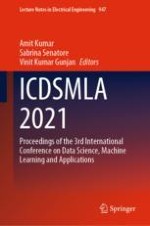2023 | Book
ICDSMLA 2021
Proceedings of the 3rd International Conference on Data Science, Machine Learning and Applications
Editors: Amit Kumar, Sabrina Senatore, Vinit Kumar Gunjan
Publisher: Springer Nature Singapore
Book Series : Lecture Notes in Electrical Engineering
